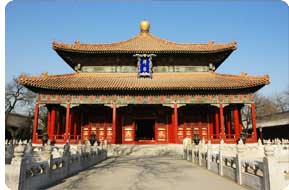 Guozijian, the Imperial College during the Yuan, Ming and Qing dynasties, can be found in Beijing’s Chengxian or Guozijian Street; It is also the site of the Kong Miao, or the Confucius Temple.
Established in the Yuan Dynasty, the Guozijian was the heart of China’s highest educational administration and college from the 1200s to the end of the Qing dynasty in the 20th century. Qing emperors gave lectures there following their coronations, their ministers and scholars would stand outside, listening. For the hard of hearing, officials stood beside the emperor and repeated everything in a loud voice. Guozijian, the Imperial College during the Yuan, Ming and Qing dynasties, can be found in Beijing’s Chengxian or Guozijian Street; It is also the site of the Kong Miao, or the Confucius Temple.
Established in the Yuan Dynasty, the Guozijian was the heart of China’s highest educational administration and college from the 1200s to the end of the Qing dynasty in the 20th century. Qing emperors gave lectures there following their coronations, their ministers and scholars would stand outside, listening. For the hard of hearing, officials stood beside the emperor and repeated everything in a loud voice.
It also served as an advanced research institute for top researchers and scholars, including many from foreign countries. In the 20th century, the author, Lu Xun, worked in the Guozijian to catalog, clean and sort the books there.
Two steles at the main gate read, Dismount Here in Chinese and in five other minority languages.
Centuries-old cypress trees dot the courtyard. The most famous is called Chu Jianbo, believed to be a human spirit who could differentiate good from evil. It is said that the tree once exposed Yan Song, a minister during the Ming, as a corrupt official by lifting his cap and dropping it on his head. The Qianlong emperor(Qing), named a small lake in the compound Ink Lake. According to legend, writers who drank from Ink Lake would have an endless source of inspiration and could therefore easily pass imperial examinations.
Piyong Hall, the main hall of Guozijian, stands in a courtyard lush with ancient trees and is surrounded by a pool. Piyong Hall was designed and built to duplicate an image from a legend of deities lecturing in a hut on a small island. One of two wells in a pavilion at Guozijian’s entrance still produces the water flowing to this pool. Water is now pumped from the well and channeled through an underground tunnel to circulate in the pool.
Rooms in the west courtyard formerly served as Guozijian classrooms but they now house Beijing Young People’s Library, a place were many middle school students congregate to read or do homework.
The Temple of Confucius stands on 20,000 square meters of the grounds of the Guozijian. Emperors of the Yuan, Ming and Qing dynasties regularly conducted ceremonies honoring Confucius in the temple’s Dacheng Hall, or Great Achievement Hall. Ten stone drums from the Qianlong reign still stand at the Dacheng Hall.
Of the more than 50,000 people during the Yuan, Ming and Qing dynasties, who successfully took examinations and became jingshi, the basic grade of a successful candidate in imperial examination, all have their names, their origins and positions inscribed on 198 steles on either side of Dacheng Gate.
|

